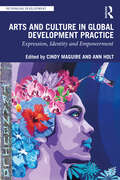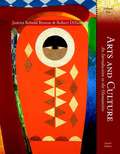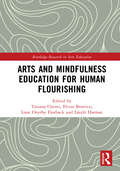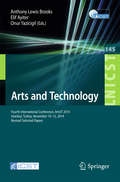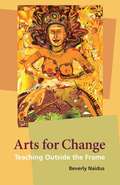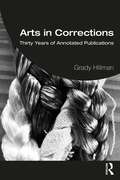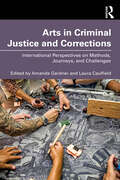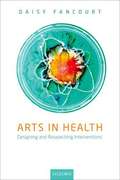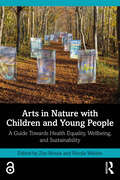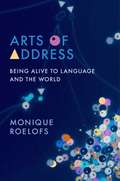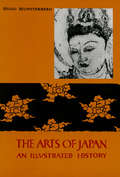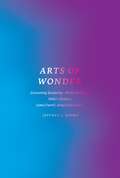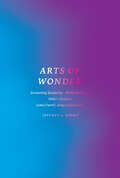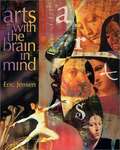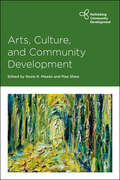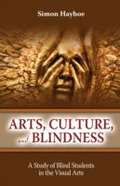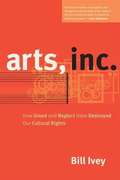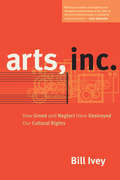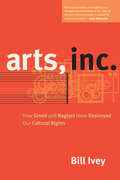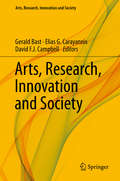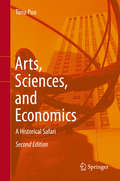- Table View
- List View
Arts and Culture in Global Development Practice: Expression, Identity and Empowerment (Rethinking Development)
by Cindy Maguire and Ann HoltThis book explores the role that arts and culture can play in supporting global international development. The book argues that arts and culture are fundamental to human development and can bring considerable positive results for helping to empower communities and provide new ways of looking at social transformation. Whilst most literature addresses culture in abstract terms, this book focuses on practice-based, collective, community-focused, sustainability-minded, and capacity-building examples of arts and development. The book draws on case studies from around the world, investigating the different ways practitioners are imagining or defining the role of arts and culture in Belize, Canada, China, Ethiopia, Guatemala, India, Kosovo, Malawi, Mexico, Peru, South Africa, Sri Lanka, Taiwan, Thailand, the USA, and Western Sahara refugee camps in Algeria. The book highlights the importance of situated practice, asking what questions or concerns practitioners have and inviting a dialogic sharing of resources and possibilities across different contexts. Seeking to highlight practices and conversations outside normative frameworks of understanding, this book will be a breath of fresh air to practitioners, policy makers, students, and researchers from across the fields of global development, social work, art therapy, and visual and performing arts education.
Arts and Culture: An Introduction to the Humanities
by Robert Diyanni Janetta Rebold BentonFor one semester/quarter courses on Introduction to the Humanities or Cultural Studies. Now in full color, Arts and Culture provides an introduction to global civilizations and their artistic achievements, history, and cultures. The authors consider two important questions: What makes a work a masterpiece of its type? And what qualities of a work enable it to be appreciated over time? Critical thinking is also highlighted throughout the text with 4 different box features that ask students to explore connections across the humanities and different cultures. These boxes are entitled Connections, Cross Currents, Then & Now, and Cultural Impact boxes. Open the new fourth edition of Arts and Culture and open a world of discovery.
Arts and Culture: An Introduction to the Humanities, Volume I
by Janetta Rebold Benton Robert DiYanniFor one semester/quarter courses on Introduction to the Humanities or Cultural Studies. <p><p>Now in full color, Arts and Culture provides an introduction to global civilizations and their artistic achievements, history, and cultures. The authors consider two important questions: What makes a work a masterpiece of its type? And what qualities of a work enable it to be appreciated over time? Critical thinking is also highlighted throughout the text with 4 different box features that ask students to explore connections across the humanities and different cultures. These boxes are entitled Connections, Cross Currents, Then & Now, and Cultural Impact boxes. Open the new fourth edition of Arts and Culture and open a world of discovery.
Arts and Health Promotion: Tools and Bridges for Practice, Research, and Social Transformation
by J. Hope Corbin Mariana Sanmartino Emily Alden Hennessy Helga Bjørnøy UrkeThis open access book offers an overview of the beautiful, powerful, and dynamic array of opportunities to promote health through the arts from theoretical, methodological, pedagogical, and critical perspectives. This is the first-known text to connect the disparate inter-disciplinary literatures into a coherent volume for health promotion practitioners, researchers, and teachers. It provides a one-stop depository for using the arts as tools for health promotion in many settings and as bridges across communities, cultures, and sectors. The diverse applications of the arts in health promotion transcend the multiple contexts within which health is created, i.e., individual, community, and societal levels, and has a number of potential health, aesthetic, and social outcomes. Topics covered within the chapters include: Exploring the Potential of the Arts to Promote Health and Social Justice Drawing as a Salutogenic Therapy Aid for Grieving Adolescents in Botswana Community Theater for Health Promotion in Japan From Arts to Action: Project SHINE as a Case Study of Engaging Youth in Efforts to Develop Sustainable Water, Sanitation, and Hygiene Strategies in Rural Tanzania and India Movimiento Ventana: An Alternative Proposal to Mental Health in Nicaragua Using Art to Bridge Research and Policy: An Initiative of the United States National Academy of Medicine Arts and Health Promotion is an innovative and engaging resource for a broad audience including practitioners, researchers, university instructors, and artists. It is an important text for undergraduate- and graduate-level courses, particularly in program planning, research methods (especially qualitative methodology), community health, and applied art classes. The book also is useful for professional development among current health promotion practitioners, community nurses, community psychologists, public health professionals, and social workers.
Arts and Mindfulness Education for Human Flourishing (Routledge Research in Arts Education)
by László HarmatThis edited volume explores the role of arts and meditation within educational settings, and looks in particular at the preventive and developmental function of the arts in educational contexts through different theoretical perspectives. Encompassing research from an array of disciplines including theatre, psychology, neuroscience, music, psychiatry, and mindfulness, the book draws insights relevant to a broad spectrum of interdisciplinary fields. Chapters are divided into thematic sections, each outlining praxes and emphasising how educating within and through the arts can provide tools for critical thinking, creativity and a sense of agency, consequently fulfilling the need of well-being and contributing towards human flourishing. Ultimately, the book focuses on the role the arts have played in our understanding of physical and mental health, and demonstrates the new-found significance of the discipline in the wake of the COVID-19 pandemic. With its interdisciplinary and timely nature, this book will be essential reading for scholars, academics, and post-graduate researchers in the field of arts education, creative therapies, neuroscience, psychology, and mindfulness.
Arts and Technology: Fourth International Conference, ArtsIT 2014, Istanbul, Turkey, November 10-12, 2014, Revised Selected Papers (Lecture Notes of the Institute for Computer Sciences, Social Informatics and Telecommunications Engineering #145)
by Anthony Lewis Brooks Elif Ayiter Onur YazicigilThis book constitutes the thoroughly refereed proceedings of the Fourth International Conference on Arts and Technology, ArtsIT 2014, held in Istanbul, Turkey, in November 2014. The 17 revised full papers presented were carefully selected and reviewed from numerous submissions. ArtsIT has become a leading scientific forum for the dissemination of cutting-edge research results in the area of arts, design and technology. The papers focus on IT technologies, artists, designers and industrial members and offer content creators tools that expand the means of expression of the traditional design field.
Arts for Change: Teaching Outside the Frame
by Beverly NaidusBeverly Naidus shares her passion and strategies for teaching socially engaged art, offering, as well, a short history of the field and the candid views of more than thirty colleagues. A provocative, personal look at the motivations and challenges of teaching socially engaged arts, Arts for Change overturns conventional arts pedagogy with an activist's passion for creating art that matters.How can polarized groups work together to solve social and environmental problems? How can art be used to raise consciousness? Using candid examination of her own university teaching career as well as broader social and historical perspectives, Beverly Naidus answers these questions, guiding the reader through a progression of steps to help students observe the world around them and craft artistic responses to what they see. Interviews with over 30 arts education colleagues provide additional strategies for successfully engaging students in what, to them, is most meaningful.
Arts in Corrections: Thirty Years of Annotated Publications
by Grady HillmanIn Arts in Corrections, the author—a poet, translator and teacher—takes readers on a chronological journey through an annotated selection of 24 of his own publications from 1981 to 2014 which recount his experiences teaching, consulting and documenting US arts programs in prisons, jails and juvenile facilities. Anyone interested in corrections and arts-in-corrections will be drawn in by the poetic sensibility Hillman brings to his writing. Readers will gain a historical and personal perspective not only into correctional arts programming in the US over the last 40 years, but also the institutional transformations in policy, culture, populations, economics, and the criminological mission expansion into other institutional settings like K-12 education. Original essays, articles, monographs and poems are interspersed with recent annotations to deliver not only a top-down view of the correctional system but also the author’s personal journey of "discouragement and hope" from work conducted in approximately 200 adult and juvenile facilities in 30 states and six countries. This comprehensive book is essential reading for a broad cross-section of international readers interested in and involved in the arts-in-corrections field. With two million individuals behind bars in the US at any given time, the profile of arts programs in prisons and jails is rising and interest in criminal-justice matters more generally is increasing. This includes not only arts-in-corrections professionals, policy makers, students, researchers, advocates and academics, but professionals in multiple other fields as well as the general public.
Arts in Criminal Justice and Corrections: International Perspectives on Methods, Journeys, and Challenges
by Amanda Gardner and Laura CaulfieldOffering a lively, international, and interdisciplinary introduction to research on arts programmes in prisons, Arts in Criminal Justice and Corrections is the first volume to bring together leading figures from the USA, the UK, Australia, New Zealand, and Belgium to explore key methodological approaches and issues through the lens of the researchers themselves.Beginning with the original pioneers of research into the arts in corrections in the USA in the 1980s, this book highlights the role of researchers in evidencing impact and influencing policy. Contributors include those who were themselves once incarcerated and those who have transitioned from practitioner to criminologist. Chapters lay the groundwork for discussion on how an important avenue for rehabilitation and re-entry can be developed, providing a call to action for more research into a field which holds promise for building a more just, equitable, and inclusive society.This book is essential reading for criminologists engaged in prisons, corrections, and desistance research, as well as researchers and practitioners in the arts and rehabilitation.
Arts in Health: Designing and Researching Interventions
by Daisy FancourtArts in Health: Designing and Researching Interventions provides a complete overview of how to go about undertaking research and practice in the field of arts in health. It starts by exploring the context for arts in health interventions, including the history of the use of arts in health and the theoretical and political developments that have laid the foundations for its flourishing. It also considers what 'arts in health' encompasses and the range of disciplines involved. Part II examines how to design an arts in health intervention, develop partnerships and find funding and considers the sensitivities around working in healthcare. Part III considers the value of research for the field of arts in health and how to design and undertake a research project. Part IV provides a fact file of arts in health research and practice, showing how the arts can be applied and the benefits they can bring across a range of medical disciplines. The book will be valuable for researchers, practitioners, healthcare professionals and those interested in learning more about the field.
Arts in Nature with Children and Young People: A Guide Towards Health Equality, Wellbeing, and Sustainability
by Nicola Walshe Zoe MoulaThis novel text brings together research and practice on the intersection between arts and nature and their impact on children and young people’s wellbeing, health equality and sustainability.Existing literature focuses on either the impact of the arts or the impact of being in/with nature on children’s and young people’s wellbeing. However, the intersection between the two – arts and nature – and their combined effect on wellbeing has received limited attention. Through five research-based and seven practice-based chapters, this book draws upon arts-in-nature practices that incorporate visual arts, music, movement, drama and poetry, in a range of natural environments, such as forests, beaches, greenhouses, parks, community areas and school playgrounds.Arts in Nature with Children and Young People will appeal to anyone working with children and young people, including mental health and healthcare professionals, teachers, researchers, artists, and arts therapists. It is also an accessible guide for parents and families looking for inspiration and ideas for creative and outdoor activities.
Arts of Address: Being Alive to Language and the World (Columbia Themes in Philosophy, Social Criticism, and the Arts)
by Monique RoelofsModes of address are forms of signification that we direct at living beings, things, and places, and they at us and at each other. Seeing is a form of address. So are speaking, singing, and painting. Initiating or responding to such calls, we participate in encounters with the world. Widely used yet less often examined in its own right, the notion of address cries out for analysis.Monique Roelofs offers a pathbreaking systematic model of the field of address and puts it to work in the arts, critical theory, and social life. She shows how address props up finely hewn modalities of relationality, agency, and normativity. Address exceeds a one-on-one pairing of cultural productions with their audiences. As ardently energizing tiny slippages and snippets as fueling larger impulses in the society, it activates and reaestheticizes registers of race, gender, class, coloniality, and cosmopolitanism. In readings of writers and artists ranging from Julio Cortázar to Jamaica Kincaid and from Martha Rosler to Pope.L, Roelofs demonstrates the centrality of address to freedom and a critical political aesthetics. Under the banner of a unified concept of address, Hume, Kant, and Foucault strike up conversations with Benjamin, Barthes, Althusser, Fanon, Anzaldúa, and Butler. Drawing on a wide array of artistic and theoretical sources and challenging disciplinary boundaries, the book illuminates address’s significance to cultural existence and to our reflexive aesthetic engagement in it. Keeping the reader on the lookout for flash fiction that pops up out of nowhere and for insurgent whisperings that take to the air, Arts of Address explores the aliveness of being alive.
Arts of Impoverishment: Beckett, Rothko, Resnais
by Leo Bersani Ulysse DutoitWhy taunt and flout us, as Beckett's writing does? Why discourage us from seeing, as Mark Rothko's paintings often can? Why immobilize and daze us, as Alain Resnais' films sometimes will? Why, Leo Bersnai and Ulysse Dutoit ask, would three acknowledged masters of their media make work deliberately opaque and inhospitable to an audience? This book shows how such crippling moves may signal a profoundly original - and profoundly anti-modernist - renunciation of art's authority.
Arts of Japan
by Hugo MunsterbergArts of Japan was originally published by Tuttle Publishing in print form in 1957.<P><P> This book," in the words of the author, "represents an attempt to fill a long-felt need for an account of the history of Japanese art which would deal with the crafts as well as with the so-called fine arts and carry the story of Japanese art up to the present day instead of ending with the death of Hiroshige." The reader will quickly perceive how well this aim has been achieved. Here, in a stimulating and informative text and 121 well-selected plates -12 in full colour-is a dynamic treatment of the various influences that have shaped the course of Japanese art history in the fields of painting, sculpture, architecture, and handicrafts. Discussed with challenging insight are the impact of the various Indian and Chinese schools, the pervasive influenceof Zen philosophy, and the many other artistic developments, giving the reader awell-rounded picture of the great significance and contribution of Japanese art. Special features of the book are sections on handicrafts and a chapter on prehistoric art. The book comes at a time when there is an awakened interest in Oriental art throughout the world. At the same time new methods of art research have been so expanded and refined that many interpretations of earlier writers have been made obsolete. Because of linguistic barriers, political upheavals, and the limited number of specialists, misconceptions have been especially numerous in the field of Oriental art. THE ARTS OF JAPAN admirably corrects these misinterpretations, consolidates the results of the most recent scholarship, and in one compact volume presents an up-to-date, authoritative survey of Japanese an throughout its long history and in all its colorful diversity.
Arts of Perception: The Epistemological Mentality of the Spanish Baroque, 1580-1720
by Jeremy RobbinsArts of Perception offers a new account of a key period in Spanish history and culture and a fundamental reassessment of its major writers and intellectuals, including Gracián, Quevedo, Calderón, Saavedra Fajardo, López de Vega, and Sor Juana. Reading these figures in the context of European thought and the new science, and philosophy, the study considers how they developed various ‘arts of perception’ - complex perceptual strategies designed to overcome and exploit epistemic problems to enable an individual to act effectively in the moral, political, social or religious sphere. The study takes as its subject the distinctive epistemological mentality behind such ‘arts of perception’. This mentality was fostered by the creative interaction of scepticism and Stoicism, and found expression in the key concepts ser/parecer and engaño/desengaño. The work traces the emergence, development, and impact of these concepts on Spanish thought and culture. As well as offering new interpretations of specific major figures, Arts of Perception offers an interpretation of the mentality of an entire culture as it made the fraught transition to intellectual modernity. As such it ranges over numerous discourses and formative contexts and provides a wealth of new material which will be of use to all those seeking to understand and interpret the literature, culture and thought of Golden Age Spain. This book was previously published as a special issue of The Bulletin of Spanish Studies.
Arts of Wonder: Enchanting Secularity--Walter De Maria, Diller + Scofidio, James Turrell, Andy Goldsworthy
by Jeffrey L. Kosky"The fate of our times is characterized by rationalization and intellectualization and, above all, by 'the disenchantment of the world. '" Max Weber's statement remains a dominant interpretation of the modern condition: the increasing capabilities of knowledge and science have banished mysteries, leaving a world that can be mastered technically and intellectually. And though this idea seems empowering, many people have become disenchanted with modern disenchantment. Using intimate encounters with works of art to explore disenchantment and the possibilities of re-enchantment, Arts of Wonder addresses questions about the nature of humanity, the world, and God in the wake of Weber's diagnosis of modernity. Jeffrey L. Kosky focuses on a handful of artists--Walter De Maria, Diller + Scofidio, James Turrell, and Andy Goldworthy--to show how they introduce spaces hospitable to mystery and wonder, redemption and revelation, and transcendence and creation. What might be thought of as religious longings, he argues, are crucial aspects of enchanting secularity when developed through encounters with these works of art. Developing a model of religion that might be significant to secular culture, Kosky shows how this model can be employed to deepen interpretation of the art we usually view as representing secular modernity. A thoughtful dialogue between philosophy and art, Arts of Wonder will catch the eye of readers of art and religion, philosophy of religion, and art criticism.
Arts of Wonder: Enchanting Secularity—Walter De Maria, Diller + Scofidio, James Turrell, Andy Goldsworthy (Religion And Postmodernism Ser.)
by Jeffrey L. Kosky“The fate of our times is characterized by rationalization and intellectualization and, above all, by ‘the disenchantment of the world.’” Max Weber’s statement remains a dominant interpretation of the modern condition: the increasing capabilities of knowledge and science have banished mysteries, leaving a world that can be mastered technically and intellectually. And though this idea seems empowering, many people have become disenchanted with modern disenchantment. Using intimate encounters with works of art to explore disenchantment and the possibilities of re-enchantment, Arts of Wonder addresses questions about the nature of humanity, the world, and God in the wake of Weber’s diagnosis of modernity. Jeffrey L. Kosky focuses on a handful of artists—Walter De Maria, Diller + Scofidio, James Turrell, and Andy Goldsworthy—to show how they introduce spaces hospitable to mystery and wonder, redemption and revelation, and transcendence and creation. What might be thought of as religious longings, he argues, are crucial aspects of enchanting secularity when developed through encounters with these works of art. Developing a model of religion that might be significant to secular culture, Kosky shows how this model can be employed to deepen interpretation of the art we usually view as representing secular modernity. A thoughtful dialogue between philosophy and art, Arts of Wonder will catch the eye of readers of art and religion, philosophy of religion, and art criticism.
Arts with the Brain in Mind
by Eric JensenHow do the arts stack up as a major discipline? What is their effect on the brain, learning, and human development? How might schools best implement and assess an arts program? Eric Jensen answers these questions--and more--in this book. To push for higher standards of learning, many policymakers are eliminating arts programs. To Jensen, that's a mistake. This book presents the definitive case, based on what we know about the brain and learning, for making arts a core part of the basic curriculum and thoughtfully integrating them into every subject. Separate chapters address musical, visual, and kinesthetic arts in ways that reveal their influence on learning. What are the effects of a fully implemented arts program? The evidence points to the following: * Fewer dropouts* Higher attendance* Better team players * An increased love of learning* Greater student dignity* Enhanced creativity* A more prepared citizen for the workplace of tomorrow* Greater cultural awareness as a bonus To Jensen, it's not a matter of choosing, say, the musical arts over the kinesthetic. Rather, ask what kind of art makes sense for what purposes. How much time per day? At what ages? What kind of music? What kind of movement? Should the arts be required? How do we assess arts programs? In answering these real-world questions, Jensen provides dozens of practical, detailed suggestions for incorporating the arts into every classroom.
Arts, Culture and Community Development (Rethinking Community Development)
by Rosie R. Meade and Mae ShawHow and why are arts and cultural practices meaningful to communities? Highlighting examples from Lebanon, Latin America, China, Ireland, India, Sri Lanka and beyond, this exciting book explores the relationship between the arts, culture and community development. Academics and practitioners from six continents discuss how diverse communities understand, re-imagine or seek to change personal, cultural, social, economic or political conditions while using the arts as their means and spaces of engagement. Investigating the theory and practice of ‘cultural democracy’, this book explores a range of aesthetic forms including song, music, muralism, theatre, dance, and circus arts.
Arts, Culture, and Blindness: A Study of Blind Students in the Visual Arts
by Simon HayhoeThis book explores one of the most powerful myths in modern society: the myth that blind people are incapable of understanding and creating visual arts.
Arts, Inc.: How Greed and Neglect Have Destroyed Our Cultural Rights
by Bill IveyIn this impassioned and persuasive book, Bill Ivey assesses the current state of the arts in America and finds cause for alarm. Even as he celebrates our ever-emerging culture and the way it enriches our lives here at home while spreading the dream of democracy around the world, he points to a looming crisis.
Arts, Inc.: How Greed and Neglect Have Destroyed Our Cultural Rights
by Bill IveyIn this impassioned and persuasive book, Bill Ivey, the former chairman of the National Endowment for the Arts, assesses the current state of the arts in America and finds cause for alarm. Even as he celebrates our ever-emerging culture and the way it enriches our lives here at home while spreading the dream of democracy around the world, he points to a looming crisis. The expanding footprint of copyright, an unconstrained arts industry marketplace, and a government unwilling to engage culture as a serious arena for public policy have come together to undermine art, artistry, and cultural heritage--the expressive life of America. In eight succinct chapters, Ivey blends personal and professional memoir, policy analysis, and deeply held convictions to explore and define a coordinated vision for art, culture, and expression in American life.
Arts, Inc.: How Greed and Neglect Have Destroyed Our Cultural Rights
by Bill IveyIn this impassioned and persuasive book, Bill Ivey, the former chairman of the National Endowment for the Arts, assesses the current state of the arts in America and finds cause for alarm. Even as he celebrates our ever-emerging culture and the way it enriches our lives here at home while spreading the dream of democracy around the world, he points to a looming crisis. The expanding footprint of copyright, an unconstrained arts industry marketplace, and a government unwilling to engage culture as a serious arena for public policy have come together to undermine art, artistry, and cultural heritage—the expressive life of America. In eight succinct chapters, Ivey blends personal and professional memoir, policy analysis, and deeply held convictions to explore and define a coordinated vision for art, culture, and expression in American life.
Arts, Research, Innovation and Society (Arts, Research, Innovation and Society)
by Elias G. Carayannis David F. J. Campbell Gerald BastThis book explores - at the macro, meso and micro levels and in terms of qualitative as well as quantitative studies - theories, policies and practices about the contributions of artistic research and innovations towards defining new forms of knowledge, knowledge production, as well as knowledge diffusion, absorption and use. Artistic research, artistic innovations and arts-based innovations have been major transformers, as well as disruptors, of the ways in which societies, economies, and political systems perform. Ramifications here refer to the epistemic socio-economic, socio-political and socio-technical base and aesthetic considerations on the one hand, as well as to strategies, policies, and practices on the other, including sustainable enterprise excellence, considerations in the context of knowledge economies, societies and democracies. Creativity in general, and the arts in particular, are increasingly recognized as drivers of cultural, economic, political, social, and scientific innovation and development. This book examines how one could derive and develop insights in these areas from the four vantage points of Arts, Research, Innovation and Society. Among the principal questions that are examined include: - Could and should artists be researchers? - How are the systems of the Arts and Sciences connected and/or disconnected? - What is the impact of the arts in societal development? - How are the Arts interrelated with the mechanisms of generating social, scientific and economic innovation? As the inaugural book in the Arts, Research, Innovation and Society series, this book uses a thematically wide spectrum that serves as a general frame of reference for the entire series of books to come.
Arts, Sciences, and Economics: A Historical Safari
by Tönu PuuThis book deals with the economic aspects of changing attitudes in arts and sciences. The effects of the public good character of culture, along with the very long production period and lifetime for its products, are emphasized, since both contribute to the failure of normal market solutions. Embodiment of ideas and the consequences of modern reproduction technology for protection of property rights are closely examined. The evolution within arts and sciences, which often seems to return to previously scrapped ideals, is illustrated by detailed case studies, in which the importance of changing tastes, rather than progress proper, is emphasized. The author attempts an understanding for this using Darwinian evolution in combination with modern mathematical complexity theory, expressed in terms accessible to the general reader. The second edition is extended and updated especially as regards the illustration material.
